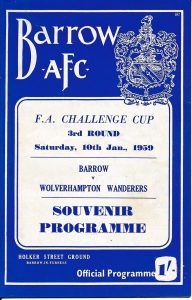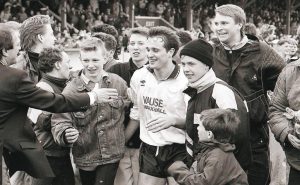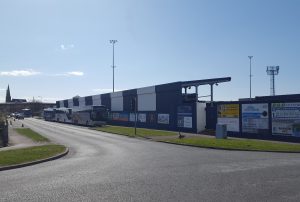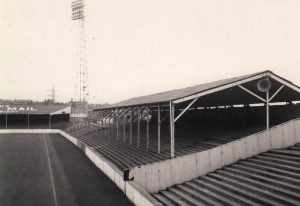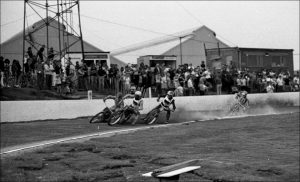Barrow 1 Port Vale 2
League 2
Saturday 2 April 2022

oi oi
The context
Number three out of four new grounds previously denied us by Covid. Barrow came up with Harrogate in 2020; this had therefore been Holker Street’s first League season since 1972 watched by fans. Given a precarious position just three points clear of relegation, it might also be the last.
The history
Barrow-in-Furness expanded rapidly during Victorian times. Mining and smelting thrived thanks to extensive iron-ore deposits, while the world’s biggest steelworks grew up at Hindpool. Vickers & Sons’ shipyard – still Britain’s largest, despite other local industries’ dramatic post-War decline – also prospered. Submarines have been built here for over a century; the football club’s badge uniquely features one.
Barrow’s fifty League seasons – from 1921 onwards – preceded another half-century of non-League obscurity. Third Division football between 1967 and 1970 was the modern highlight; record 16,000 crowds, meanwhile, had turned up for a 1954 FA Cup-tie against Swansea (Wolves’ visit five years later drew only slightly fewer). They applied for re-election just twice, in 1971 and 1972, but that uncharacteristic lapse nevertheless ended with them being ousted by media favourites Hereford.
Hard-tackling defender Brian Arrowsmith was the club’s Sixties talisman. Their foray out of Division Four crowned a record-breaking four hundred-odd Football League appearances. He returned three years later as manager, subsequently playing four more seasons in the Northern Premier League, and could still be found helping out here weeks before Covid ended his life. Holker Street’s 1998 Main Stand is named after him.
Zigger was another 1960s favourite. This curious mascot – put together by fans from basic materials, carried out before kick-off and placed behind whichever goal Barrow were attacking – remains fondly remembered by many:
“’Bean bag head and a flat cap’ is how my Dad described him.”
“As a ball-boy I used to have to carry Zigger to the centre circle. Took two of us. It resembled a boxing bag and was about as heavy. Cap optional, blue with face painted on. We were on a Zigger rota for the honour of taking him out. It was quite a treat, as you often got to shake hands with the captains.”
“Zigger was at its height of popularity around the time we were promoted in 1966-67. The first edition of the Zigger club magazine appeared in September 1967.”
“Zigger was what you used to call a ‘gonk’ We had an official club mascot who would cart Zigger about.”
“I’m not even sure there was only one Zigger. The one I remember (1971-1972) might have been a reincarnation.”
[Zigger quotes courtesy of barrowafc.net]
Manager Ray Wilkie and striker Colin Cowperthwaite illuminated Barrow’s long non-League exile. Cowperthwaite holds overall appearance and goalscoring records; his fifteen-year career achieved critical mass over five tumultuous seasons when Wilkie led them to promotion, a 1990 FA Trophy win and narrow FA Cup defeat against Bolton. Devonshire Road – which runs behind the main stand – was renamed Wilkie Road when he died suddenly in 1992.
Emlyn Hughes is the town’s best-known footballer. Although he famously failed to get trials at Holker Street, a statue of him now stands nearby. Another local success – although actually Preston-born – began appearing in Dr Who at around the time Hughes joined Blackpool. Former Barrow Grammar School boy turned repertory artist, Peter Purves, got his big break with Blue Peter while Colin Appleton’s side were winning promotion along with Stockport, Southport and Tranmere.
The journey
- in good time
- quiet streets
John came to my house and I drove us. Barrow isn’t far from Preston, but only as crows fly; getting there by car – via Ulverston (birthplace of Stan Laurel) and indifferently pleasant South Lakes countryside – doubles the distance to nearly seventy miles. Much of our route followed one single tortuous road. We lost time due to a mysteriously burning BMW near Penny Bridge but still arrived in good time, parking among quiet streets behind Lower Ormsgill Reservoir.
Holker Street lies on this isolated town’s seaward fringe. Walney Island’s windswept bulk huddles across restless water, while the sprawling shipyard is just half a mile distant. Barrow feels like one of Britain’s outposts, closer to Dublin than London; it’s understandable – but still shameful – that early-Seventies Fourth Division chairmen so cynically focussed on the admittedly tiresome trek here when re-election time came around.
The ground
- wooden (Bob Lilliman)
- neat (Legendary Football Grounds
- simple (Bob Lilliman)
Holker Street was tidy if unspectacular during Football League days. A wooden main stand faced the neat Popular Side; simple roofs sheltered both ends. Things might have stayed that way, too, but for financial problems that persuaded Barrow’s directors to flirt with speedway. Truncating one terrace created space; dirt tracks appeared around the pitch, which acquired temporary sections on wooden boards beneath each corner flag.
Many people believe this development – and more specifically its underlying causes – hastened Barrows demise. Visiting clubs certainly disliked their bouncy turf and three-sided ground, although high travel costs undoubtedly irked them more. Speedway races lasted only until 1974, when Barrow Bombers moved out; the flattened Steelworks End was then built over with unsightly but much-needed social facilities.
- popular front
- main event
- re-roofed
One of four 1963 floodlight pylons survives, while the popular terrace (now Ray Wilkie Stand) and Holker Street End are little altered fifty years on. Both have been re-roofed – the latter now features crush barriers like tank traps and over-the-top segregation, behind which visiting fans have their own section of covered standing and a tiny seating block. That functional Cross Bar complex takes up all remaining space behind the other goal. As well as dressing rooms, offices, players’ tunnel and hospitality it also contains supporters’ bar, club shop and al fresco fanzone.
Flesh and wine
We explored these amenities and promptly headed for the nearest pub. It proved to be a flat-roofed, estate type affair that – despite looking peaceful – thronged inside with home fans, daytime boozers and one or two interlopers from the Potteries keeping their heads down. Recent cold weather had relented, bright sunshine made beer-garden drinking newly attractive and kick-off time felt almost inconvenient.
Holker Street’s food hut was busy. Queuing Barrovians stretched half-way along the Wilkie Stand’s dusty back steps; a special offer on baked bean and sausage slices filled me with childish pleasure, so that I not only tried one with my meat pie but also went back for seconds. “I didn’t think anyone would buy those”, confided the woman serving me.
The game
Phil Brown had recently taken charge here. The orange-skinned manager still needed his first win, third-placed Vale didn’t seem likely to be pushovers and everything was going to plan when Brad Walker’s well-placed effort hit the post early on. But Barrow settled; Tom Beadling shot wide, then Josh Kay finished ruthlessly past Aidan Stone following a precisely pinged crossfield pass from Romeao Hutton.
Vale came alive after the break. They went level when Jamie Proctor volleyed in Harry Charsley’s cross following good work by David Amoo. Barrow were fading badly, an agitated Brown found himself booked for encroachment and tired legs gifted the still-sprightly visitors their inevitable late winner. Charsley again combined well with Proctor, setting up James Wilson who danced through Barrow’s defence to set up Aaron Martin; the big forward could hardly miss from inches out.
Teams and goals
Barrow: Farman, Hutton, Platt, Canavan, Driscoll-Glennon (James 73), Beadling, Banks, Gotts, Rooney (Gordon 73), Kay (Grayson 66), Amadi-Holloway. Unused subs: Taylor, Jones, Lillis.
Port Vale: Stone, Smith, Martin, Hall, Worrall (Edmondson 87), Charsley, Walker, Benning, Wilson (Taylor 94), Amoo (Harratt 60), Proctor. Unused subs: Hurst, Robinson, Holy.
Goals: Barrow: Kay 24. Port Vale: Proctor 59, Martin 89.
Attendance 3215.



